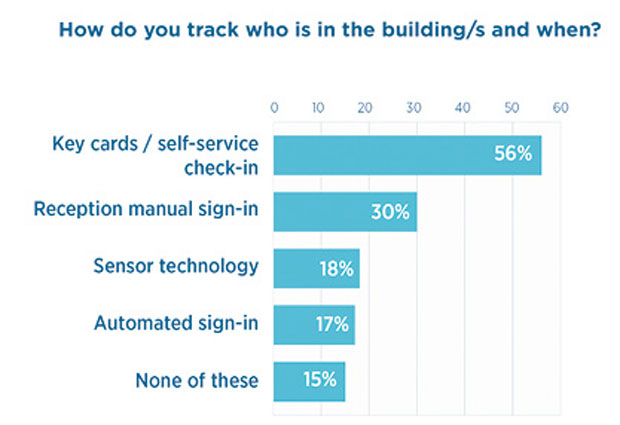PREDICTING THE FUTURE
So, if AI itself isn’t going to make that big an impact over the next 12 months, which technology will? When our survey respondents were asked this question, the most popular answer was Internet of Things sensor technology. More than one in three respondents (38 per cent) reported that they already use IoT sensors across their estate, while just under one in four (17 per cent) plan to implement the technology in the next year.
Equipping assets, rooms, and desks with sensors allows facilities managers to monitor and measure all sorts of crucial metrics, from asset performance and environmental conditions to occupancy and footfall. Live sensor data can inform decision-making on the fly, especially important as real estate strategy must become more fluid and responsive to change, while that data can be fed into analytics platforms to identify historical patterns that help facilities managers paint a longer-term picture of their needs.
Our survey findings backed up these assertions, with respondents seeing value in sensors to aid both the management of infrastructure and people. More than two in three cited tracking/improving asset performance, followed closely by tracking energy usage and output (65 per cent). Still, FM practitioners recognised significant value for sensors in tracking the occupancy and movement of people around the building (50 per cent) and monitoring environmental conditions such as weather and temperature (20 per cent).
DIGITISING THE BUILDING LIFECYCLE
Having predictive power is also crucial from a building lifecycle perspective. Digitising buildings allows facilities managers to keep a more detailed and accurate record of the total cost of ownership of their assets. Meanwhile, it ensures more seamless collaboration between different stakeholders throughout that lifecycle, creating buildings that work more effectively for their occupants.
Although our research showed that facilities managers see benefits in digitising their building, the adoption of technologies that make it possible remains relatively low. The gap between perception and application of BIM is a great example. Using information derived from digital representations of the physical and functional components of a building, BIM can be used to support strategic decision-making for the entire building lifecycle, providing visibility of lifecycle data, from design to operation and decommission. Nearly two-thirds of respondents (61 per cent) agreed that BIM and other building lifecycle software would be valuable for digitising all building information and asset data, yet more than two-thirds are either not currently using the technology (30 per cent) or have no immediate plans to use it (37 per cent).
Likewise, just six per cent reported that they currently have a full digital BIM model, while 36 per cent said they had digitised parts of their estate and assets but not all. Surprisingly, 33 per cent reported that they have no immediate plans to digitise. As was the case with AI, these findings suggest that FM practitioners understand the theoretical benefits BIM provides but few are currently exploiting the technology.







